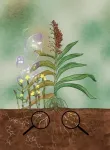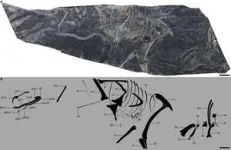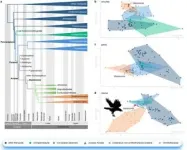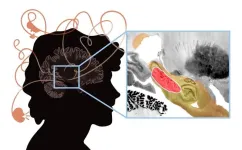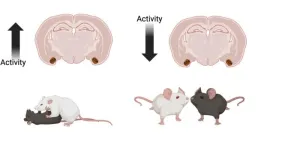Chinese scientists find key genes to fight against crop parasites
2025-02-12
(Press-News.org)
Chinese scientists have identified two key genes responsible for sorghum's resistance to Striga, a parasitic plant that causes significant crop losses. The breakthrough, which also highlights the potential of AI to predict key amino acid sites in strigolactone (SL) transporters, could have wide-ranging applications in enhancing parasitic plant resistance across various crops.
This study, published in Cell, was conducted by Prof. XIE Qi's team at the Institute of Genetics and Developmental Biology of the Chinese Academy of Sciences, in collaboration with five other institutions.
Striga, also known as "witchweed," along with other parasitic plants like Orobanche, relies on host plants for nutrients and water, severely affecting crop yields and agricultural ecosystems. Striga alone infests over 50 million hectares of farmland in Africa, causing annual economic losses of $1.5 billion and affecting over 300 million people. In China, Striga is found in regions such as Guangdong and Yunnan, while Orobanche poses a threat to crops like sunflowers and tomatoes in Inner Mongolia and Xinjiang.
Sorghum is one of the plants susceptible to Striga infestation. Sorghum roots release SLs, a class of plant hormones that help recruit mycorrhizal fungi for nutrient uptake. Unfortunately, Striga seeds dormant in the soil detect these SL signals, which trigger Striga germination and subsequent infestation of the host plant.
In this study, the researchers analyzed transcriptome data from sorghum roots under phosphorus-deficient conditions and strigolactone (SL) treatmen separately. The scientists identified two ABCG family SL transporter genes: Sorghum bicolor SL transporter 1 (SbSLT1) and Sorghum bicolor SL transporter 2 (SbSLT2). They determined that the SbSLT1 and SbSLT2 proteins control the efflux of SLs and knocking out the associated genes inhibits SL secretion. Under these conditions, Striga is unable to germinate and infect the host.
AI-based predictions further identified a conserved phenylalanine residue critical for SL transport. This residue is found not only in sorghum, but also in SL transporters across other monocot crops like maize, rice, and millet, as well as dicotyl crops such as sunflowers and tomatoes, suggesting a conserved mechanism across species. Molecular biology and cellular biology experiments demonstrate the key function of this residue.
Field trials conducted in Striga-prone areas showed that sorghum with knocked-out SbSLT1 and SbSLT2 genes exhibited 67–94% lower infestation rates and 49–52% less yield loss. These findings offer valuable genetic resources and technical support for breeding Striga-resistant sorghum varieties.
The researchers emphasized that the discovery of SbSLT1 and SbSLT2 could provide crucial tools for combating parasitic plants, potentially addressing food security challenges in countries severely affected by parasitic plants, especially African and Asian countries, thereby contributing to regional peace and stability. Future research will focus on validating these genes in crops such as maize, tomato, and millet, with the goal of advancing the commercialization of Striga-resistant crops.
END
ELSE PRESS RELEASES FROM THIS DATE:
2025-02-12
Francis Crick Institute press release
Under strict embargo: 16:00hrs GMT Wednesday 12 February 2025
Peer reviewed
Experimental study
Animals, people and cells
Researchers from the Francis Crick Institute have found that some particularly aggressive lung cancer cells can develop their own electric network, like that seen in the body’s nervous system.
This unique property could make them less dependent on the environment surrounding the tumour and even spread more easily.
Small cell lung cancer (SCLC) is one of the hardest types of cancer to ...
2025-02-12
The RNA inhibitor olpasiran significantly reduces a type of “bad cholesterol” that’s associated with a high risk of cardiovascular events, according to results from an analysis by a Mount Sinai researcher of a phase 2 trial. The study reported that higher doses of olpasiran lowered the type of cholesterol called lipoprotein(a) [Lp(a)] by more than 95 percent in participants with atherosclerotic cardiovascular disease. Findings were published February 12, 2025, in JAMA Cardiology.
“Our study is the first clinical trial to investigate the association between oxidized phospholipids on lipoprotein(a) and inflammatory mediators,” says ...
2025-02-12
Andrew Pines, MD, MA, a resident in the Department of Psychiatry at Brigham and Women’s Hospital and a researcher in the Center for Brain Circuit Therapeutics, is the lead author of a paper published in JAMA Psychiatry, Mapping Lesions That Cause Psychosis to a Human Brain Circuit and Proposed Stimulation Target.
Shan Siddiqi, MD, Assistant Professor of Psychiatry at Harvard Medical School and Director of Psychiatric Neuromodulation Research at the BWH Center for Brain Circuit Therapeutics, is the senior author of this ...
2025-02-12
**MEDIA ADVISORY**
UNDER EMBARGO UNTIL: Wednesday, February 12 at 11am EST
Nature article entitled:
A critical role for the cortical amygdala in shaping social encounters
[https://doi.org/10.1038/s41586-024-08540-4]
Bottom Line: Neural activity in the cortical amygdala determines whether mice engage in aggressive or pro-social behavior
Results: By performing a network analysis on whole-brain activity of male mice, we identified the cortical amygdala – an olfactory cortical structure – as a key brain region in promoting aggression. This brain region is activated by olfactory cues from male mice and by aggressive ...
2025-02-12
Recognition of telehealth as an effective strategy for delivering treatment for substance use disorder (SUD) has raised hopes for improving access to this treatment in settings with limited transportation or when time constraints compromise regular use of consistent access to in-person substance use treatment.
But the findings from a team of researchers from the Virginia Center for Health Innovation, UCLA, RAND, and MedInsight, Milliman Inc., suggest that the promise of telehealth may vary by insurance and geography.
New research suggests that people who live ...
2025-02-12
Monash research could transform how broken bones are treated, with the development of a special zinc-based dissolvable material that could replace the metal plates and screws typically used to hold fractured bones together.
Surgeons routinely use stainless steel or titanium, which stay in the body forever, can cause discomfort and may require follow-up surgeries. A new zinc alloy, designed by Monash biomedical engineers, could solve these problems by being mechanically strong but gentle enough to degrade safely over time while supporting optimal healing.
A study published today in Nature shows the research team’s innovative ...
2025-02-12
An increase in high-fat, high-fructose foods in people’s diets has contributed to a dramatic increase in type 2 diabetes. This, in turn, has led to an increase in peripheral neuropathy — nerve damage, typically in the hands and feet — that causes weakness, loss of sensation and, in some, a stabbing, burning, or tingling pain. About half of people with type 2 diabetes are affected, and of these, about half experience severe neuropathic pain.
The damage begins as axons from sensory neurons begin to retract and disappear from the tissues they innervate. New research from the lab of Clifford Woolf, MB, BCh, PhD, director ...
2025-02-12
A research team led by Professor WANG Min from the Institute of Vertebrate Paleontology and Paleoanthropology (IVPP) of the Chinese Academy of Sciences has discovered two bird fossils in Jurassic-era rocks from Fujian Province in southeast China. These rocks date back approximately 149 million years. The fossils fill a spatiotemporal gap in the early evolutionary history of birds and provide the evidence yet that birds were diversified by the end of the Jurassic period.
This study was published in Nature.
Birds ...
2025-02-12
Yogurt, which contains live strains of bacteria, is thought to protect against many types of diseases, with some reports indicating it could reduce risk of colorectal cancer. A new study led by investigators from Mass General Brigham finds that yogurt consumption over time may protect against colorectal cancer through changes in the gut microbiome. Using data from studies that have followed participants for decades, researchers found that long-term consumption of two or more servings per week of yogurt was tied to lower rates of proximal colorectal cancer positive ...
2025-02-12
University of Virginia Cancer Center researchers have explained the failure of immune checkpoint therapy for ovarian cancer by discovering how gut bacteria interfere with the treatment. Doctors may be able to use the findings to overcome this treatment failure and save the lives of thousands of women every year.
The new discovery, from the lab of UVA’s Melanie Rutkowski, PhD, speaks to the surprising ways that the microbiome – the collection of organisms that live on and inside our bodies – is vital not only to ...
LAST 30 PRESS RELEASES:
[Press-News.org] Chinese scientists find key genes to fight against crop parasites
